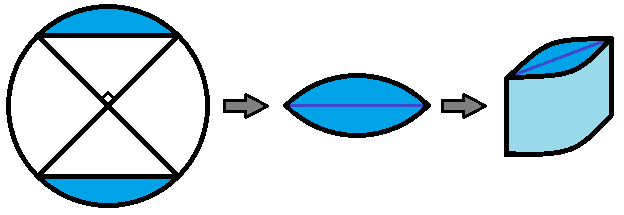Circular Segments Container
Each of the two identical circular segments colored blue in the circle has been formed by a right central angle. The two pieces are attached together along their chords to make the base of a closed right container, as shown.
If the container's volume is fixed, then its minimum surface area occurs when the ratio of its height to the circle's radius is where and are positive integers.
Find

The answer is 6.
This section requires Javascript.
You are seeing this because something didn't load right. We suggest you, (a) try
refreshing the page, (b) enabling javascript if it is disabled on your browser and,
finally, (c)
loading the
non-javascript version of this page
. We're sorry about the hassle.
Let r =radius, h =height, S =surface area, V =Volume
The area of the two segments combined is 2 ⋅ ( 4 π r 2 − 2 r 2 ) = ( 2 π − 1 ) r 2 and so V = ( 2 π − 1 ) r 2 h
Since V is fixed let's cleverly set V = 2 π − 1 so that r 2 h = 1 or h = r 2 1
S = 2 ( 2 π − 1 ) r 2 + π r h but making the above substitution gives S as a function of r :
S ( r ) = ( π − 2 ) r 2 + r π [A quick graph tells us the minimum around r = 1 . 1 will easily be found using the derivative.]
S ′ ( r ) = ( 2 π − 4 ) r − r 2 π = 0
( 2 π − 4 ) r = r 2 π
r 3 = 2 π − 4 π [The cube root of this is around 1.1 but it turns out we don't need it.]
We are told to find r h but we can substitute h = r 2 1 to get r 3 1 which is just the reciprocal of the above r 3
So the ratio is π 2 π − 4 = 2 − π 4 . This means a = 2 and b = 4 so the solution is a + b = 6